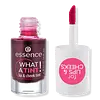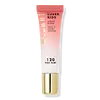What's inside
What's inside
 Key Ingredients
Key Ingredients

 Benefits
Benefits

 Concerns
Concerns

 Ingredients Side-by-side
Ingredients Side-by-side

Water
Skin ConditioningGlycerin
HumectantPropanediol
SolventBetaine
Humectant1,2-Hexanediol
Skin ConditioningPanthenol
Skin ConditioningSodium Hyaluronate
HumectantLeuconostoc/Radish Root Ferment Filtrate
AntimicrobialXanthan Gum
EmulsifyingVaccinium Macrocarpon Fruit Extract
AstringentEthylhexylglycerin
Skin ConditioningLactic Acid
BufferingSodium Hydroxide
BufferingCitric Acid
BufferingPhenoxyethanol
PreservativeParfum
MaskingCI 16035
Cosmetic ColorantCI 42090
Cosmetic ColorantCI 45410
Cosmetic ColorantWater
Skin ConditioningIsododecane
EmollientPEG-10 Dimethicone
Skin ConditioningButylene Glycol
HumectantDimethicone
EmollientTriethylhexanoin
MaskingDicaprylyl Carbonate
EmollientEthylhexyl Isononanoate
EmollientCetyl PEG/PPG-10/1 Dimethicone
EmulsifyingVinyl Dimethicone/Methicone Silsesquioxane Crosspolymer
Glycerin
HumectantSodium Chloride
MaskingMica
Cosmetic ColorantPhenoxyethanol
PreservativeDimethicone Crosspolymer
Emulsion StabilisingDisteardimonium Hectorite
StabilisingPolyglyceryl-2 Triisostearate
EmulsifyingSodium Dehydroacetate
PreservativeMethyl Methacrylate Crosspolymer
Ethylhexylglycerin
Skin ConditioningRosa Centifolia Flower Water
Skin ConditioningTriethoxycaprylylsilane
Citrus Medica Vulgaris Fruit Extract
AntioxidantIsopropyl Titanium Triisostearate
EmollientTriethoxysilylethyl Polydimethylsiloxyethyl Dimethicone
Skin ConditioningPunica Granatum Fruit Juice
MaskingCI 77891
Cosmetic ColorantCI 15850
Cosmetic ColorantIron Oxides
CI 19140
Cosmetic ColorantWater, Isododecane, PEG-10 Dimethicone, Butylene Glycol, Dimethicone, Triethylhexanoin, Dicaprylyl Carbonate, Ethylhexyl Isononanoate, Cetyl PEG/PPG-10/1 Dimethicone, Vinyl Dimethicone/Methicone Silsesquioxane Crosspolymer, Glycerin, Sodium Chloride, Mica, Phenoxyethanol, Dimethicone Crosspolymer, Disteardimonium Hectorite, Polyglyceryl-2 Triisostearate, Sodium Dehydroacetate, Methyl Methacrylate Crosspolymer, Ethylhexylglycerin, Rosa Centifolia Flower Water, Triethoxycaprylylsilane, Citrus Medica Vulgaris Fruit Extract, Isopropyl Titanium Triisostearate, Triethoxysilylethyl Polydimethylsiloxyethyl Dimethicone, Punica Granatum Fruit Juice, CI 77891, CI 15850, Iron Oxides, CI 19140
 Reviews
Reviews

Ingredients Explained
These ingredients are found in both products.
Ingredients higher up in an ingredient list are typically present in a larger amount.
Ethylhexylglycerin (we can't pronounce this either) is commonly used as a preservative and skin softener. It is derived from glyceryl.
You might see Ethylhexylglycerin often paired with other preservatives such as phenoxyethanol. Ethylhexylglycerin has been found to increase the effectiveness of these other preservatives.
Glycerin is already naturally found in your skin. It helps moisturize and protect your skin.
A study from 2016 found glycerin to be more effective as a humectant than AHAs and hyaluronic acid.
As a humectant, it helps the skin stay hydrated by pulling moisture to your skin. The low molecular weight of glycerin allows it to pull moisture into the deeper layers of your skin.
Hydrated skin improves your skin barrier; Your skin barrier helps protect against irritants and bacteria.
Glycerin has also been found to have antimicrobial and antiviral properties. Due to these properties, glycerin is often used in wound and burn treatments.
In cosmetics, glycerin is usually derived from plants such as soybean or palm. However, it can also be sourced from animals, such as tallow or animal fat.
This ingredient is organic, colorless, odorless, and non-toxic.
Glycerin is the name for this ingredient in American English. British English uses Glycerol/Glycerine.
Learn more about GlycerinPhenoxyethanol is a preservative that has germicide, antimicrobial, and aromatic properties. Studies show that phenoxyethanol can prevent microbial growth. By itself, it has a scent that is similar to that of a rose.
It's often used in formulations along with Caprylyl Glycol to preserve the shelf life of products.
Water. It's the most common cosmetic ingredient of all. You'll usually see it at the top of ingredient lists, meaning that it makes up the largest part of the product.
So why is it so popular? Water most often acts as a solvent - this means that it helps dissolve other ingredients into the formulation.
You'll also recognize water as that liquid we all need to stay alive. If you see this, drink a glass of water. Stay hydrated!
Learn more about Water